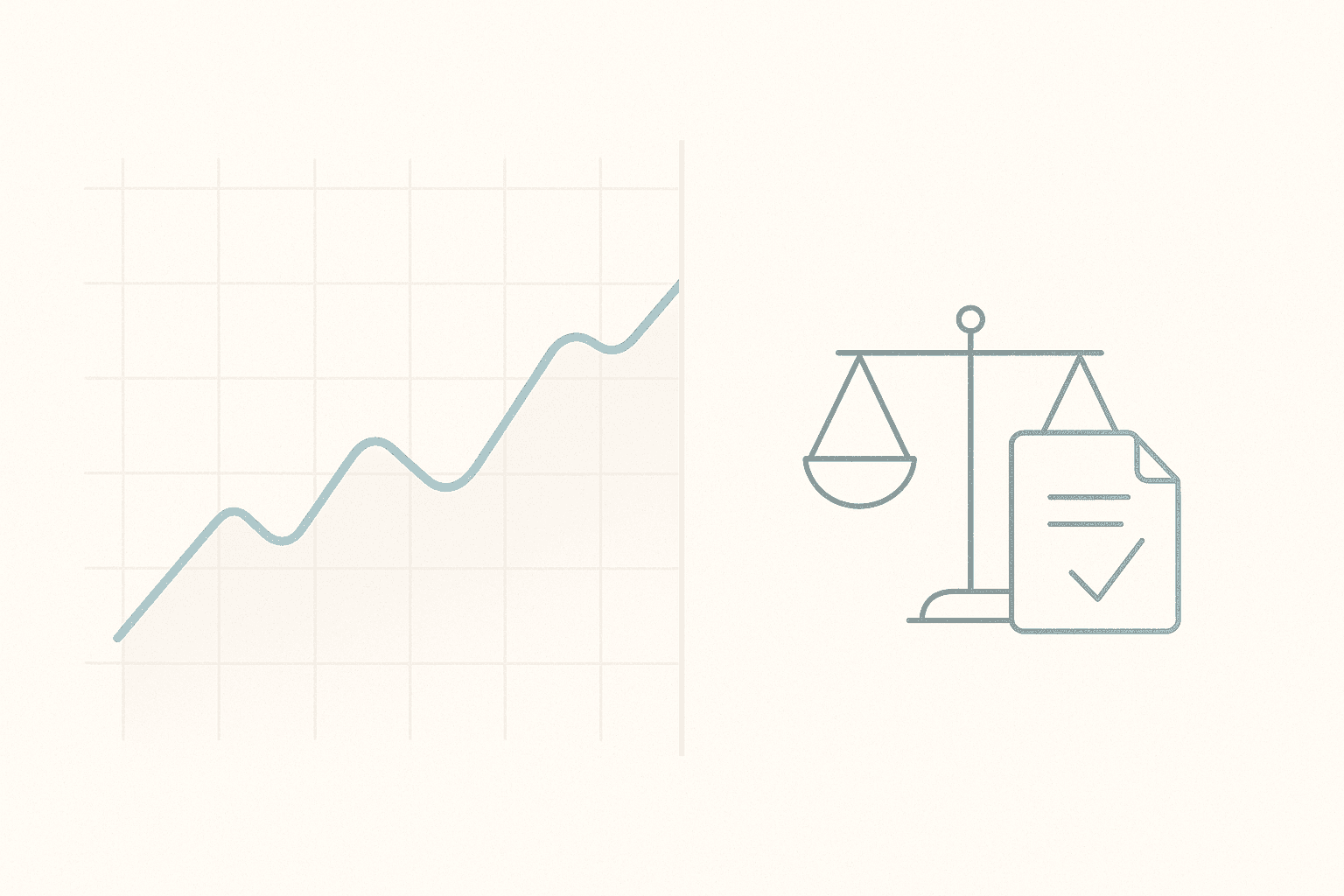AI Lawyer Blog
Profit and Loss (P&L) Statement Template — Free Download

Greg Mitchell | Legal consultant at AI Lawyer
3
A Profit and Loss Statement (P&L), also called an income statement, is one of the three core financial statements businesses rely on to measure financial health. It summarizes revenue, costs, and expenses over a defined period — often monthly, quarterly, or annually — to show net profit or loss. This document isn’t just for accountants; it’s a vital tool for business owners, investors, and lenders to assess performance.
According to the U.S. Small Business Administration, more than 30.2 million small businesses operate in the United States, and regular financial reporting, including P&L statements, is essential for securing loans and managing operations.
Download the free Profit and Loss Statement Template or customize one with our AI Generator — then have a local attorney review before you sign.
This guide is part of our Financial Agreements series — guiding individuals and businesses through secure money management and lending practices.
You Might Also Like:
Child Travel Consent Form Template (Free Download + AI Generator)
Tax Power of Attorney Template (Free Download + AI Generator)
1. What Is a Profit and Loss Statement
A Profit and Loss Statement is a structured financial report showing how much money a company has earned and spent over a given period. It includes revenues from sales, expenses like salaries and utilities, and ultimately shows net profit or net loss.
While balance sheets give a snapshot of assets and liabilities, and cash flow statements show money movement, the P&L reveals how well the business is operating day-to-day. Companies of all sizes — from startups to multinationals — must prepare P&Ls regularly for compliance, investor relations, and internal decision-making.
2. Why P&L Statements Matter in 2025?
There are several reasons P&Ls are crucial today:
Business Growth: Lenders and investors often require consistent P&Ls to evaluate funding decisions.
Economic Transparency: According to the U.S. Census Bureau, retail sales in 2024 reached $7.4 trillion, showing the scale of activity tracked through financial reports like P&Ls.
Global Compliance: International businesses face diverse accounting standards (GAAP in the U.S., IFRS globally) and accurate P&Ls ensure comparability.
For 2025, when businesses are under pressure to demonstrate resilience, P&Ls act as proof of sustainability and help forecast future growth.
3. Key Components of a P&L
A properly drafted P&L should include the following:
Revenue: Total income from sales of goods and services.
Cost of Goods Sold (COGS): Direct costs tied to production or purchase of inventory.
Gross Profit: Revenue minus COGS, showing production efficiency.
Operating Expenses: Salaries, rent, utilities, and other overhead.
Operating Income: Gross profit minus operating expenses.
Other Income/Expenses: Interest, asset sales, or other non-operational items.
Taxes: Income tax obligations.
Net Income (Net Profit/Loss): Final result after all expenses are deducted.
4. Legal and Accounting Requirements by Region
The structure and compliance rules for P&Ls vary:
United States: GAAP requires companies to follow standardized formats. Public companies file quarterly and annual income statements with the SEC.
European Union & UK: IFRS requires uniform reporting. Listed companies must present comprehensive income including foreign exchange and other adjustments.
Canada: IFRS applies for public firms, while private entities may use ASPE (Accounting Standards for Private Enterprises).
Global Trend: Increasing push for transparency and digital filing obligations across jurisdictions.
Businesses must align their P&Ls to these frameworks to avoid penalties and to ensure credibility with investors.
5. How to Customize Your Profit and Loss Statement
Customization ensures the P&L reflects your unique business model:
Tailor revenue categories to align with different income streams.
Add line items for significant expenses such as R&D or marketing.
Separate recurring vs. one-off income/expenses for clarity.
Use templates that match GAAP or IFRS standards depending on jurisdiction.
Include comparative periods to highlight growth or downturns.
6. Step-by-Step Guide to Preparing One
Follow these steps to create a reliable P&L:
Step 1 - Gather Records: Collect sales invoices, receipts, payroll data, and expense records.
Step 2 - Record Revenue: Enter all income from sales or services for the period.
Step 3 - Subtract COGS: Deduct production or inventory costs to calculate gross profit.
Step 4 - Add Operating Expenses: Input all overhead costs, from rent to salaries.
Step 5 - Include Other Items: Add interest, asset sales, or one-time transactions.
Step 6 - Calculate Taxes: Apply applicable federal, state, or local tax rates.
Step 7 - Finalize Net Income: Determine profit or loss after all deductions.
Step 8 - Review & File: Cross-check for errors and ensure it complies with local standards.
7. Tips for Compliance and Accuracy
Use accounting software with GAAP/IFRS compliance checks.
Reconcile bank statements with recorded revenues and expenses.
Break down expenses into categories to monitor cost drivers.
Involve a certified accountant or auditor to verify accuracy.
Keep backups of all source documents for audits.
8. Checklist Before Finalizing Your P&L
Revenue and expense entries are complete.
Gross profit and operating income calculated correctly.
All taxes accounted for under current law.
Extraordinary items clearly separated.
Totals verified against supporting documents.
Comparative figures included where applicable.
Compliance with GAAP or IFRS confirmed.
Download the Full Checklist Here
9. Common Mistakes to Avoid
Recording revenue before it is actually earned.
Mixing business and personal expenses.
Forgetting to include depreciation or amortization.
Not updating P&L regularly, leading to outdated insights.
Using incorrect tax rates or ignoring local tax obligations.
10. FAQs
Q: What is the difference between a P&L and a cash flow statement?
A: A P&L measures profitability by showing revenue, expenses, and net income for a defined period. A cash flow statement tracks actual cash moving in and out, grouped into operating, investing, and financing activities. A business can show profit on the P&L while still facing cash shortages if receivables are slow or inventory is high. Lenders and investors review both because profit and liquidity answer different questions. Using the pair helps you spot timing issues and plan funding needs.
Q: How often should a small business prepare a P&L?
A: At a minimum, you should produce an annual P&L for tax filing and year-end review. Monthly or quarterly statements are better because they reveal trends, seasonality, and early warning signs. Frequent reporting also improves budgeting, pricing decisions, and expense control. Many lenders and grant programs request the most recent period, so staying current avoids delays. Regular cadence also reduces errors that build up when records sit too long.
Q: Can individuals or freelancers use a P&L?
A: Yes, freelancers and sole proprietors rely on a P&L to track income streams and deductible expenses. It simplifies quarterly estimated taxes and supports loan or rental applications that require proof of earnings. A categorized P&L shows which services are most profitable and which costs should be trimmed. It also helps set aside cash for taxes and plan irregular income. Over time, the P&L becomes your roadmap for pricing and growth.
Q: Do investors and lenders really look at P&Ls?
A: Absolutely, because a P&L reveals margins, cost structure, and operating leverage. Investors use it to evaluate scalability, while lenders test coverage ratios and stability of earnings. Trend lines across several periods matter as much as the latest number. Clean formatting and consistent accounting policies build credibility. Clear notes on unusual items keep reviewers from misreading your performance.
Q: What software is best for preparing a P&L?
A: Mainstream options like QuickBooks, Xero, and FreshBooks generate reliable P&Ls with minimal setup. Choose based on your region, bank integrations, and inventory or project needs. Look for features like multi-currency support, role permissions, and audit trails if you plan to scale. Templates aligned to GAAP or IFRS reduce formatting work and errors. Try a short trial and check how easily it exports reports for your accountant.
Sources and References
Data and regulatory insights in this guide are informed by official and publicly available sources, including the U.S. Small Business Administration Office of Advocacy small business statistics, U.S. Census Bureau retail trade data, and reporting frameworks under U.S. GAAP, IFRS Standards, and CPA Canada’s ASPE guidance.
References to financial reporting obligations and investor requirements are based on U.S. Securities and Exchange Commission disclosure rules for public companies and common lending documentation practices, while practical implementation examples reflect features described in leading accounting software providers such as QuickBooks, Xero, and FreshBooks.
Disclaimer
This article is provided for informational purposes only and does not constitute financial or legal advice. Always consult a certified accountant or attorney in your jurisdiction before preparing or relying on a Profit and Loss Statement.
Get Started Today!
A Profit and Loss Statement is more than numbers — it’s the backbone of financial planning, compliance, and credibility. By drafting one accurately, you safeguard your business against surprises and provide a clear picture for investors and lenders.
Download the free Profit and Loss Statement Template or customize one with our AI Generator — then have a local attorney review before you sign.
Explore more resources in our Financial Agreements series to secure your money management and lending practices.
You Might Also Like:



